|
Cowan's
Corner
Southwestern American Indian Jewelry
A Stylish Investment
By Wes Cowan and Danica Farnand
If you have ever been to Santa Fe, it is hard not to notice, or even buy, a
piece of American Indian jewelry. Whether a sexy concha belt, a delicately
stamped bracelet, or a necklace strung with turquoise, southwestern Indian
silversmithing and jewelry is beautiful and distinctive. However, the jewelry
has not always been what we see under the veranda of the Palace of the Governor.
Silver work is a relatively new craft to the American Indians. Traveling
Mexican artisans, known as plateros, taught their trade to the Navajo in the
1850s. Early Navajo silver work was made with very heavy silver hammered from
U.S. and Mexican coins, candlesticks, and teakettles. Despite a lack of proper
silversmith tools, the craft was quickly perfected. As symbols of family wealth,
jewelry was worn extensively, doubling as collateral at trading posts. It wasn't
until 1890 that shells and turquoise were introduced as design elements.
With the emergence of western railroads, the dynamics of the craft changed.
The Fred Harvey Company, as it "civilized" the southwest, enticed American
tourists to visit. As part of the business, Navajo and Pueblo silversmiths (as
well as other craftsmen) were hired to create souvenirs. The Harvey Company
supplied the artisans with sheet silver and pre-cut turquoise. Because of the
quantity of trinkets needed and the type of material supplied, the quality of
the jewelry diminished. During the early part of the 20th century, the west
boomed and increased the demand for cheaper souvenirs. The Harvey Company
replaced American Indian artisans with machines, stamping the necklaces and
bracelets with arrows, thunderbirds and lightning, and selling the pieces as
authentic Indian art.
Thirty years later, the Federal Government formed the
Indian Arts and Crafts Board and prohibited misrepresentation of Indian art. At
this time, the Board also attempted to increase interest and sales of the arts
by exhibiting at San Francisco's 1939 Golden Gate International Exposition,
exposing the American public to the artisans and their work. Today, a person of
an established tribe must make items labeled "American Indian".
From
"baroque-style" squash-blossom necklaces to hip-hugging concha belts, Navajo and
Puebloan jewelry has changed throughout the decades to suit the tastes and
fashions of America. Contemporary artist Dan Simplicio (1917-1969, Zuni)
popularized nugget-style jewelry. Using chunks of polished turquoise, he
carefully set them into stamped silver and enhanced the designs with fine pieces
of coral branches. He was also one of the first at Zuni to work with gold. His
bold uses of design and innovative techniques have made him one of the most
desired and respected of Zuni silversmiths. Simplicio's work can be seen at the
Heard Museum in Phoenix, the Minneapolis Institute of Arts, Minneapolis, and
Ohio University.
The Hopi artist Charles Loloma (1921-1991) is another
craftsperson whose work is widely recognized for its beauty. His groundbreaking
style has bridged traditional with modern; creating bracelets and pendants using
mosaic inlay and sand-cast techniques. Loloma studied under the famous Hopi
artist Fred Kabotie and assisted in the painting of a series of murals at the
1939 Golden Gate International Exposition. He began to make jewelry in 1955,
when he experimented with turquoise, coral, shell, pearls, ebony, vermillion
wood and ironwood. By the 1970s, his work proliferated, and he began to exhibit
at contemporary art museums and shows around the world. After his death in 1991,
the Southwestern Association of Indian Arts honored Loloma with the Lifetime
Achievement Award for Indian Affairs.
Newest trends in the collecting market
center on quality jewelry made from 1950-1970. The current exhibit at the
Wheelwright Museum in Santa Fe displays more than 400 pieces of Charles Loloma's
work. Inlaid bracelets of his have sold at auction for over $20,000. Preston
Monongye's work, (1927-1987, Navajo) was recently exhibited at the American
Museum of Natural History in New York City and sells at similar prices. The
slight deviation from traditional forms and the exquisite handling of material
is what intrigues collectors.
Tips for Buying Genuine American Indian Jewelry and Crafts
American Indian
arts and crafts are sold through many outlets, including tourist stores, gift
shops and art galleries. Here are some tips from the Federal Trade Commission
and the Indian Arts and Crafts Board to help you shop wisely:
1. Buy from an
established dealer who will give you a written guarantee or written verification
of authenticity. Ask if your item comes with a certification tag. While not all
authentic Indian arts and crafts carry this tag, those that do are certified by
the Department of the Interior (DOI) to be genuine.
2. Get a receipt that
includes information about the value of your purchase and any verbal
representations by the salesperson. For example, if the salesperson tells you
that the piece of jewelry you are buying is sterling silver and natural
turquoise and was handmade by an American Indian artisan, make sure this
information is documented on your receipt.
3. Before buying American Indian
arts and crafts at powwows, annual fairs, juried competitions, and other events,
check the event requirements for information about the authenticity of the
products for sale. Many events list their requirements in newspaper ads,
promotional flyers and printed programs. If the event organizers don't say
anything about the authenticity of the American Indian arts and crafts for sale,
get written verification for any item you buy that is sold as authentic.
Identifying Authentic American Indian Jewelry
It's not always easy to spot
a counterfeit item, but price, materials, appearance, and the seller's guarantee
of authenticity may help.
Price:
Today, a collector can find an assortment of jewelry to suit his or
her taste. Popular items, such as concha belts, turquoise rings, and inlaid pins
can be found in a variety of styles and prices. Although Indians make and sell
inexpensive souvenir-type items, authentic high-quality Indian jewelry can be
expensive.
Type of materials:
Most Indian artisans use sterling
silver complemented with opaque stones, such as coral, onyx, shell, turquoise,
lapis lazuli, or carnelian.
Appearance:
Well-crafted jewelry has no wavering lines or lopsided
designs. If a design is stamped into silver-the most common metal used-the image
should be clear. Images on imitations often are blurred. High-quality pieces use
stones that are well cut and uniform in size, and fit snugly into their
settings. The stones on imitations may be poorly cut, leaving a large amount of
metal-colored glue visible between the stone and the metal. Look for the
artist's "hallmark" stamped on the jewelry. Many Indian artists use a hallmark,
such as a symbol or a signature, to identify their work.
Guarantee of authenticity:
A reputable dealer will give you a written
guarantee.
 Cowan's Auctions, Inc.
(www.cowanauctions.com
) in Cincinnati, OH, specializes in the sale of historic
Americana, European and American furniture, decorative arts, and American Indian
arts. An internationally recognized expert in historic Americana, Wes Cowan
stars in the PBS TV series History Detectives and is a featured appraiser on
Antiques Roadshow. He can be reached via email at info@historicamericana.com. Cowan's Auctions, Inc.
(www.cowanauctions.com
) in Cincinnati, OH, specializes in the sale of historic
Americana, European and American furniture, decorative arts, and American Indian
arts. An internationally recognized expert in historic Americana, Wes Cowan
stars in the PBS TV series History Detectives and is a featured appraiser on
Antiques Roadshow. He can be reached via email at info@historicamericana.com.
|
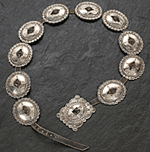
This Navajo Concha Belt
with classic period
design features leather strap lacing through the opening in the center of each
concha. It recently sold for $1,265.

This lot of three Navajo Fred
Harvey-style bracelets fetched $632 at auction.
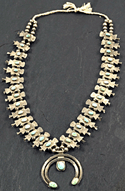
Navajo squash
blossom necklace, ca. 1930, features a silver naja with three turquoise stones
hanging from two rows of silver beads with 30 blossoms, each with a turquoise
stone. Hand-made 20" necklace is strung on cotton string; realized
$575.
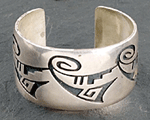
A signed Hopi bracelet with bold overlay design
consisting of three identical swirling and stepped motifs.
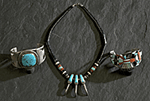
Signed Zuni and Navajo bracelets and
turquoise bear claw necklace, includes a beautifully crafted Zuni split shank
bracelet decorated with a Rainbow god, tortoise shell stockings and tips on
feathers, marked on back "E.A. Zuni," width 1.6"; a bold Navajo bracelet with a
large turquoise, signed "3H" in a stylized hogan with smoke drifting upward,
width 1.6"; and a Pueblo necklace with jet (?), turquoise, pipestone, and shell
beads, ornaments of hand-made silver claws set with turquoise, length 17.5";
price realized, $431.25.
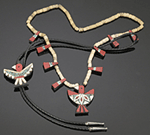
This Pueblo Depression-Era necklace
and bola includes a necklace made to resemble a squash blossom necklace with
central thunderbird and eight tabs mounted on 78 record and decorated with
gypsum, red plastic, and crushed turquoise, length 25" x bird height 2.25"; and
a black leather bola with similar thunderbird fashioned from same depression
materials and with silver tips. Bird drilled to hang as pendant, height of bird
1.75"; $632.50.
All photos courtesy of Cowan's Auctions, Inc.,
Cincinnati, OH
|